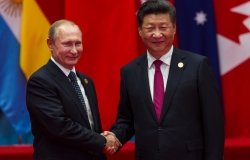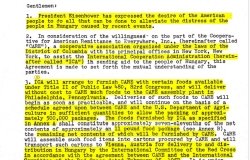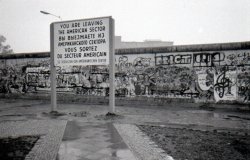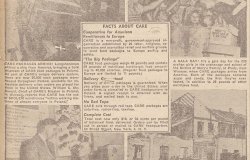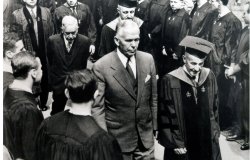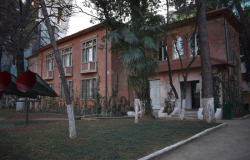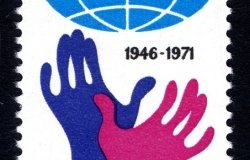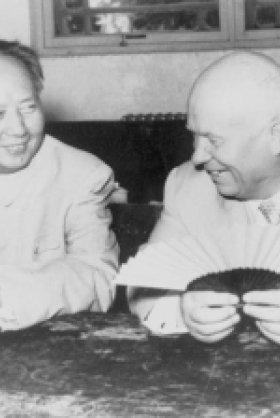
A blog of the History and Public Policy Program
CARE Comes to Africa
In the autumn of 1961, a group of mission chiefs from the Cooperative for American Remittances Everywhere (CARE) traveled to Sierra Leone, Nigeria, Cameroon, and Liberia.
In the autumn of 1961, against the backdrop of a rapidly changing world marked by the swift decolonization of the African continent, a contingent of skilled mission chiefs from the Cooperative for American Remittances Everywhere (CARE) traveled to Sierra Leone, Nigeria, Cameroon, and Liberia.
Their primary objective was to assess levels of need and develop plans for CARE-sponsored projects, as described in a letter written by one of the group members.[1] This endeavor required the men to forge relationships with local and national governments and agencies of the US government operating in each country. Among the architects of this “Africa Task Force” were William Rayman and Wells Klein, who, over a few short weeks, cultivated programs that balanced the complex and often competing desires of the various groups they encountered with the needs of a country’s residents.
Despite some interest in Africa from CARE staff in the years prior and the organization’s other ventures into the Global South throughout the 1950s, it was only after the 1960 wave of decolonization that CARE turned its attention more seriously towards the continent.[2] Once the Task Force arrived in Africa, Klein, Rayman and their associates worked quickly. In a matter of weeks, the men arrived in Freetown, Sierra Leone, split up to survey the country’s needs, drafted project proposals, presented a budget and solicited financing, developed an agreement with the government in Freetown, and began laying the groundwork for a new CARE mission there before moving on to Nigeria.[3]
A school feeding program was operational in Sierra Leone by the following April and the first cadre of CARE-trained Peace Corps volunteers arrived in October.[4] The swift establishment of the Sierra Leone mission was, in part, a response to what Rayman described as a “constant parade” of committees, voluntary agencies, and survey teams traveling to the country in the aftermath of independence. However, many of these organizations quickly abandoned their efforts. For CARE to establish a mission and develop a harmonious partnership with the government, they had to demonstrate their commitment quickly to distinguish themselves from the multitude of agencies that had come and gone.
Sierra Leone and Liberia emerged as the most fertile ground for CARE’s initial endeavors on the African continent. Setting up a mission in a former colony was a daunting task. Although much of CARE’s early experience involved orchestrating aid programs amidst the chaos of war-torn nations and the accompanying logistical difficulties, operating within an organized administrative framework, as they found in Sierra Leone, presented a more manageable landscape. Rural development, which was the focus of CARE’s early work in the country, was also simplified by Sierra Leone’s extensive local organization and the feasibility of transportation to rural areas.
Moreover, there were two major interests in Sierra Leone that CARE found themselves able to accommodate. The first was the Government of Sierra Leone’s aspiration to invest in the nation’s political future, which hinged on nurturing the educational prospects of the next generation of leaders. However, Sierra Leone faced a dual challenge: a limited school attendance problem intertwined with and exacerbated by a childhood nutrition problem. Klein and Rayman found that they could address both issues through a program that delivered ingredients to schools and equipped individuals with the skills to cook meals for students each day.[5] What made this project more feasible was CARE’s extensive experience in shipping and distributing food, which had been a cornerstone of their aid efforts in other regions. As such, the organization could leverage existing relationships and expertise to procure and ship ingredients.
Secondly, the US Ambassador to Sierra Leone, A.S.J. Carnahan, expressed a keen interest in providing American aid to the hinterlands “to show them that someone is interested in their well-being.” This aligned with the director of the nascent Peace Corps’ desire to collaborate with American voluntary agencies and involve them in Peace Corps volunteer training, an initiative that CARE had already undertaken in Colombia.[6] The need for hands-on rural aid in Sierra Leone provided an opportunity for CARE to enlist more Peace Corps volunteers to assist with education and the development of infrastructure in rural areas.
William Rayman’s letter to Richard Reuter not only reflects the swiftness with which CARE established its presence in Sierra Leone but also showcases its ability to tailor programs to align with the desires of several stakeholders. These few weeks laid the foundation for a mission in Sierra Leone that operates to this day and involved the American government in a program intended to demonstrate to Sierra Leoneans that the United States was invested in their welfare, a critical strategy in America’s Cold War era pursuit of influence in the Global South.
[1] Sam Kaufman, Draft of “CARE, A History,” 1971, MssCol 470, box 4, CARE Records, The New York Public Library, New York. 19, 29.
[2] Charles R. Joy, “The CARE African Program: Some General Considerations,” May 27, 1955, MssCol 470, box 22, CARE Records, The New York Public Library, New York.
[3] William Rayman, Letter to Richard Reuter, September 11, 1961, MssCol 655, box 22, CARE Records, The New York Public Library, New York.
[4] Sierra Leone School Feeding Program, MssCol 470, box 147, CARE Records, The New York Public Library, New York. ; Robert M. Golding, Letter to Richard Vogler, MssCol 470, box 1156, CARE Records, The New York Public Library, New York.
[5] “A CARE Program for Sierra Leone,” September 19, 1961, MssCol 470, box 605, CARE Records, The New York Public Library, New York. ; Wells Klein, Letter to Richard W. Reuter and Fred Devine, September 16, 1961, MssCol 470, box 605, CARE Records, The New York Public Library, New York.
[6] Heike Wieters, “Ever Tried—Ever Failed? The Short Summer of Cooperation between CARE and the Peace Corps,” International Journal 70, no. 1 (March 1, 2015): 152-153.
About the Author
Kiera Eriksen-McAuliffe
Kiera Eriksen-McAuliffe is a member of the CARE Global Research Team, which is researching the history of this pivotal non-profit organization in the context of American foreign aid, the Cold War and the Postcolonial world. The CARE Global Research Team is made up of scholars from around the world and is sponsored by the Wilson Center.

History and Public Policy Program
The History and Public Policy Program makes public the primary source record of 20th and 21st century international history from repositories around the world, facilitates scholarship based on those records, and uses these materials to provide context for classroom, public, and policy debates on global affairs. Read more
